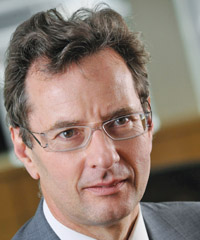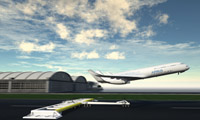Special Report: Technology
Bringing flights of fantasy to life
Revolutionary ideas about the future of flight from an Airbus think tank could become real time by 2050.
November 1st 2012
Imagine a big commercial jet, its undercarriage retracted, sitting atop a trolley on the threshold of the runway. The trolley, linked to a track system using electro-magnetic motors, quickly accelerates and throws the aircraft into the air, rather like a navy fighter being catapulted from an aircraft carrier. Read More »
 |
| 'You can have the latest aircraft design, but if you have to circle around Heathrow Airport for 45 minutes where is the benefit?' |
| Charles Champion Executive Vice-President Engineering Airbus |
This is just one revolutionary idea to emerge from Airbus Smart Skies, the latest instalment of its Future by Airbus project.
The idea, said Airbus executive vice-president engineering, Charles Champion, amounts to assisted take-off. “The idea is that you push the aircraft faster into the air. This means you need a shorter runway, therefore you need less space for the airport,” he said.
“The point is to use energy from the ground. This is easier to do in a more reliable manner than use the fuel on board the aircraft to fly.”
It would mean that aircraft could be lighter, with smaller engines consuming less fuel, he added. All of which means an optimized aircraft could climb to its most efficient cruising altitude more quickly in a continuous “eco-climb”, cutting noise and CO2 emissions.
With less time and distance required for take-off, runways could be shortened by up to a third, minimizing land use and enabling airport capacity to increase or new micro-airports to emerge. They could be located near city centres – or new mega-cities – with space becoming even more of a premium.
Champion believes passengers need have no fear. “Acceptable acceleration and deceleration limits of passengers would need to be determined, but the experience would be more akin to a comfortable children’s funfair ride rather than a high-octane white knuckle theme park ride,” he said.
Airbus’ innovation think tank goes even further. It suggests the ultimate concept would be to have a system that also captures a landing aircraft, removing the need for landing gear. This would require all airports to have the same system and to accommodate all routes along with alternative/diversion airports.
This latest instalment of the Future by Airbus Smarter Skies considers how aircraft are operated on the ground and in the air in order to meet expected air traffic growth.
The ideas come from a dedicated team of up to 30 Airbus engineers - all volunteers - tasked with “thinking outside the square”.
 |
| An Airbus computer generated view of the future of flight, catapulting tomorrow’s aircraft into the air from a ‘trolley’ |
Champion said environmental targets set by the industry would only be met by a combination of investment in smarter aircraft design and optimizing the environment in which the aircraft operates. “That is why our latest Future by Airbus Smarter Skies concepts focus not just on what we fly, but how we may fly in 2050 and beyond,” he said.
Apart from assisted take-offs, the Smarter Skies vision consists of four other concepts:
• Aircraft in free flight and formation along “express skyways”. Highly intelligent aircraft would be able to “self-organize” and select the most efficient and environmentally friendly routes (free flight), making the optimum use of prevailing weather and atmospheric conditions.
• Low-noise, free-glide approaches and landings, reducing emissions during the overall descent and reducing noise during a steeper approach with no need for engine thrust or air breaking. These approaches would also reduce the landing speed earlier, making shorter landing distances achievable.
• Low emission ground operations. On landing aircraft engines could be switched off sooner and runways cleared faster, cutting ground handling emissions. Technology could optimize an aircraft’s landing position with enough accuracy for an autonomous renewably powered taxi-ing carriage to be ready so aircraft can be transported away from runways quicker. This would optimize terminal space and remove runway and gate limitations.
• Powering future aircraft and infrastructure. The use of sustainable biofuels and other potential alternative energy sources such as electricity, hydrogen and solar, would be necessary to secure supply and further reduce aviation’s environmental footprint.
While assisted take-offs may be decades away, Champion said Airbus was actively working on concepts such as “green taxi-ing”, a taxi-ing tug which could attach itself to the aircraft. Remotely controlled, it could be operated by the plane’s pilot from the cockpit, removing the need for ground handling staff.
Champion pointed out that if the Air Traffic Management (ATM) system and technology on board the aircraft were optimized, recent research by Airbus suggested flights in Europe and the U.S. could on average be around 13 minutes shorter, with flight lengths in other parts of the world also cut.
“You can have the latest aircraft design, but if you have to circle around Heathrow Airport for 45 minutes where is the benefit? When we asked travellers what their biggest annoyance [in flying] was the answer was delays and late arrivals,” said Champion.
“Thirteen minutes per flight doesn’t seem a lot, but it includes lost time in taxi-ing and it’s probably a lot more at a large airport like Frankfurt or Paris. Assuming around 30 million flights per year are made, this would save around nine million tonnes of excess fuel annually, which equates to over 28 million tonnes of avoidable CO2 emissions and a saving of five million hours of excess flight time.
“Add to this new aircraft design, alternative energy sources and new ways of flying and you could see even more significant improvements.”
Champion said airports, air traffic management, aircraft manufacturers and airlines need to become more engaged in finding solutions to the issues facing aviation.
“The most difficult part is not the technical part, it is to listen to each other and understand what are the constraints of the other guy and how you can design an aircraft aviation system which is more efficient than today.”